What Does an Old Tradition Consider to Be the First Christian Art Work?
The scriptures have for many centuries been a source of inspiration for Christian painters and sculptors. They have influenced neat artists in many eras, leaving behind masterful examples of Medieval Christian fine art and religious Renaissance fine art for us to explore and enjoy. Let us take a deeper look at the history of Christian artwork, Christian sculpture, and famous biblical paintings.
Table of Contents
- i A Brief History of Early Christian Fine art
- 1.i Symbolism in Early Christian Fine art
- 1.2 Early on Christian Art Before 313 CE
- 1.3 Early Christian Art Subsequently 313 CE
- 2 Religious Renaissance Fine art
- 2.ane Madonna and Child (c. 1300) past Duccio di Buoninsegna
- two.2 The Last Supper (c. 1495) by Leonardo da Vinci
- 2.iii The Creation of Adam (1512) past Michelangelo
- 2.four The Tower of Babel (1563) by Pieter Bruegel the Elder
- three Notable Early on Christian Artworks
- iii.1 Sarcophagus of Junius Bassus
- iii.two Basilica of Sant'Apollinare Nuovo
- 3.3 Moses Hit the Rock (1624) – Joachim Anthonisz Wtewael
- iii.4 Adoration of the Magi (1481) by Leonardo da Vinci
- 3.5 Transfiguration (1516 – 1520) by Raphael
- iv Frequently Asked Questions
- iv.1 Why Is It So Difficult to Detect Early Examples of Christian Art?
- 4.two What Subject field Matter Did Early Christian Artists Paint?
A Brief History of Early Christian Art
Tracing the early days of Christian artwork can exist a difficult chore to undertake. Earlier 100 CE, Christians were a persecuted minority, and then the chances of them existence allowed to create art at this fourth dimension were rather slim. At that time, Christianity was a pocket-size fringe organized religion with very few followers and little to no public recognition or support, so Christian painters would not accept had the luxury of fiscal back up from patrons.
It was as well forbidden to create idols, and so this also could have influenced the lack of art from before 100 CE. Historians and scholars have divided Early on Christian art into two distinct periods: Earlier 313 CE and after 313 CE, as this was the year of the Edict of Malan.
Allow united states of america now explore the various periods of early Christian artwork and Christian sculptures.
Symbolism in Early Christian Art
Under the Roman Empire in the earliest days of Christianity, Christian artwork was intentionally cryptic so that the Christian undertones could non exist noticed by the optics of the Roman oppressors. They incorporated Christian themes subtly into imagery that was accepted inside the predominantly Pagan civilisation. The get-go examples of Christian art nevertheless surviving today were constitute in the catacombs of Rome, on surfaces in Christian burial tombs, dated to exist from somewhere between the 2d to fourth centuries.
To hide the pregnant of these early on Christian artworks, artists represented the figure of Jesus symbolically with pictogram symbols such as the peacock, lamb, fish, or ballast.
The symbol of the cantankerous was not used to correspond Jesus until many centuries later, as in the early days of Christianity, crucifixion was a common form of punishment for various offenses and therefore would non take been exclusively linked with Christianity, but rather with incivility. Some other symbol often used to represent Christ was the symbol of unity and peace, the dove.
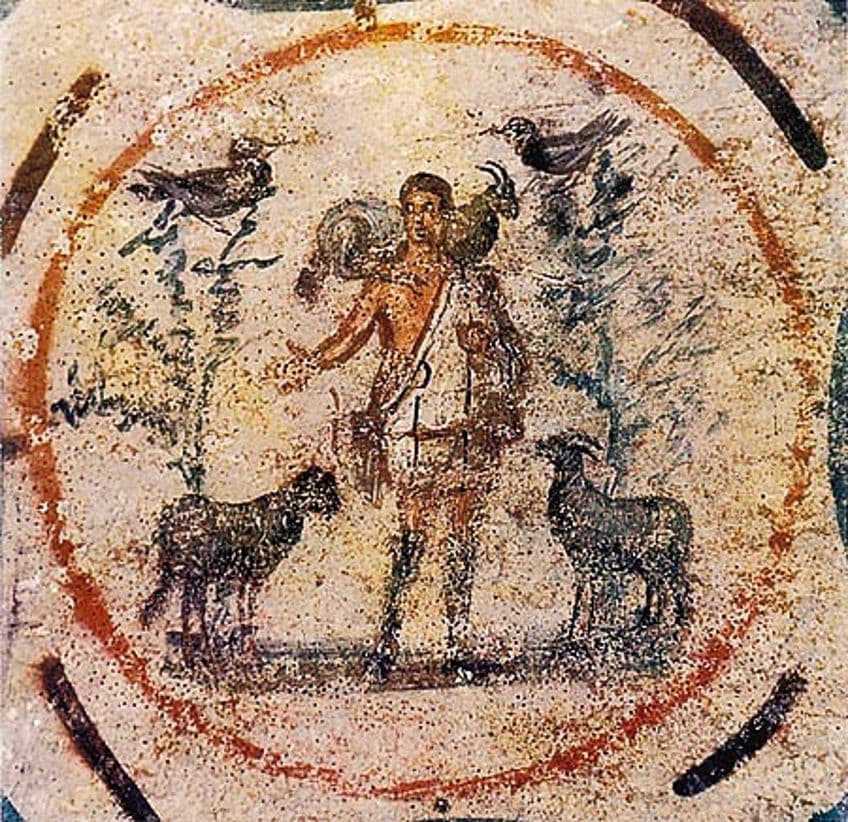 Centre of the ceiling of the "Velatio" cubicle: the Good Shepherd (also sheep and doves with olive branches in copse). Location: Catacomb of Priscilla, Italy, Rome, second half of the 3rd century;Unknown Unknown, Public domain, via Wikimedia Eatables
Centre of the ceiling of the "Velatio" cubicle: the Good Shepherd (also sheep and doves with olive branches in copse). Location: Catacomb of Priscilla, Italy, Rome, second half of the 3rd century;Unknown Unknown, Public domain, via Wikimedia Eatables
Early Christian Art Before 313 CE
Besides the early on Roman occupation discrimination against Christianity and Christian art, there are several other possible factors that could have resulted in a lack of art representing Christian figures. The people of that fourth dimension were influenced by several dissimilar theologies and philosophies; some believed that God could be experienced directly, others thought he couldn't, and others thought that if he could, so he should not be physically depicted.
Modernistic historians have suggested that it was peradventure the prominent conventionalities at the time that it was but not possible to perceive the divine, let alone recreate it.
Historians also suggest that maybe the primary reason Christian art does not exist in the earliest days of the religion is that the majority of folk were poor and did not own any holding. One time the economic situation improved for them, they were able to afford to indulge in hobbies such every bit Christian paintings, Christian sculptures, and Christian architecture.
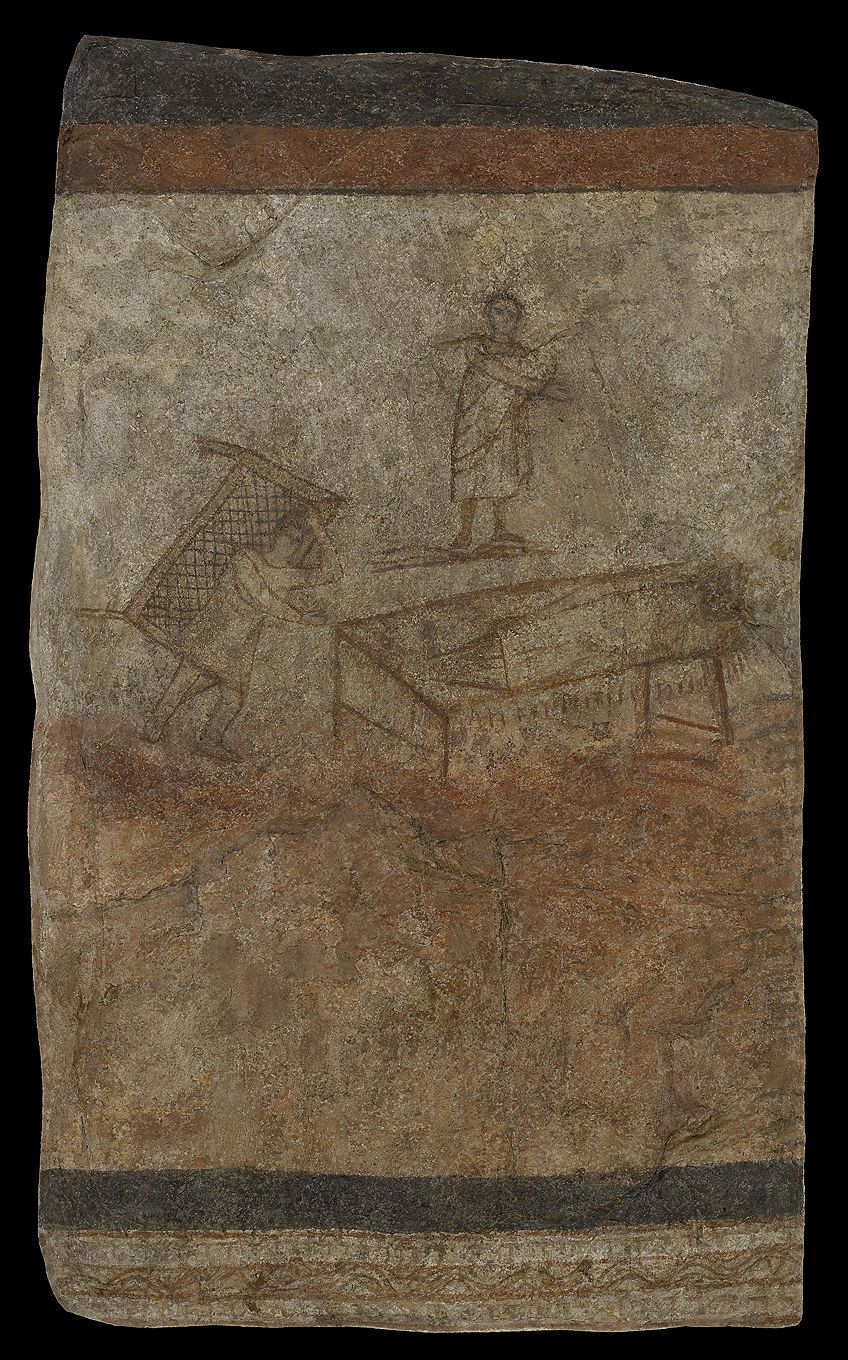 Photograph of a painting of Jesus healing the paralytic from the wall of the baptistery in the Dura-Europa church, circa 232 A.D. It is ane of the earliest visual depictions of Jesus. It was excavated by the Yale-French Excavations betwixt 1928-37 in present-day Syria and at present resides in the Yale University Art Gallery in New Haven, CT;Yale University Art Gallery, Public domain, via Wikimedia Commons
Photograph of a painting of Jesus healing the paralytic from the wall of the baptistery in the Dura-Europa church, circa 232 A.D. It is ane of the earliest visual depictions of Jesus. It was excavated by the Yale-French Excavations betwixt 1928-37 in present-day Syria and at present resides in the Yale University Art Gallery in New Haven, CT;Yale University Art Gallery, Public domain, via Wikimedia Commons
The Dura-Europos church is considered to be the oldest church nonetheless in expert condition, and information technology has been dated betwixt the periods 230 CE to 256 CE. This building was originally a house that was afterward converted into a church, and in it, in that location are biblical paintings on the walls, including images of Jesus every bit both the shepherd and the Christ. The catacombs of Rome were created a few decades before the Dura-Europos church, all the same, these earliest examples of Christian art only depicted praying as opposed to the actual epitome of Jesus seen after in the Church house.
Stylistically, these early Christian paintings that adorned the walls of the catacombs were very like to other catacombs of many other religious groups, including the Roman mystery religions, paganism, or those that belonged to members of the Jewish organized religion. Compared to the art of the rich, these paintings were relatively depression in quality, but depicted a charming expressiveness of the figures.
Early Christian art from this period ofttimes created "abbreviated" scenes, where well-known religious incidents were represented by one to four figures.
This fitted in with the Roman style of compartmentalizing the fine art in the room with various geometric layouts. A popular subject at this time was the representation of biblical figures being rescued from mortal danger in some fashion, such every bit biblical paintings depicting the Sacrifice of Isaac, Noah kneeling in prayer in the ark, the resurrection of Jesus, and Jonah and the Whale.
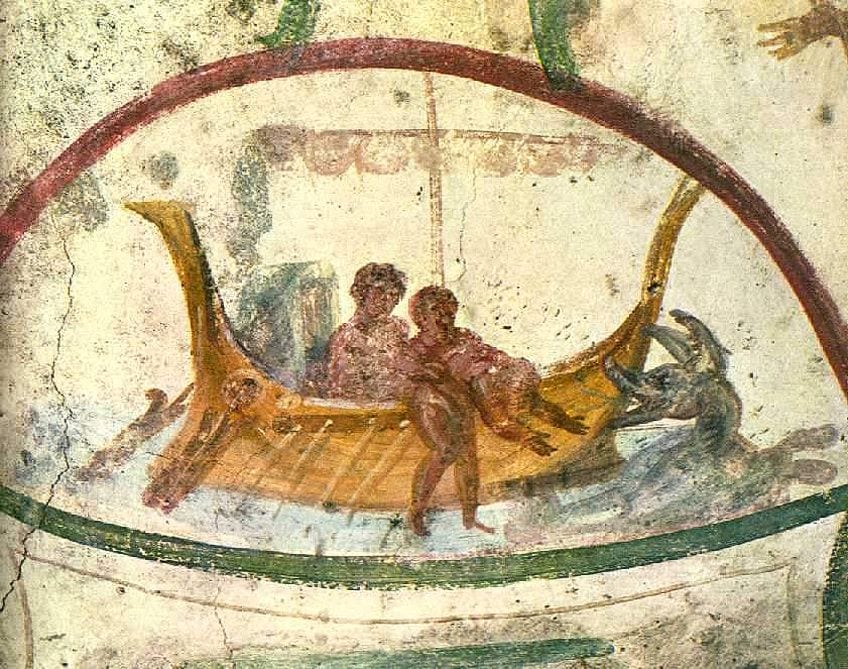 Picture of the prophet Jonah being thrown into the Sea. From the crypt of Saint Peter and Saint Marcellino, Rome, Italia, c. quaternary century;Public Domain, Link
Picture of the prophet Jonah being thrown into the Sea. From the crypt of Saint Peter and Saint Marcellino, Rome, Italia, c. quaternary century;Public Domain, Link
Christian sculptures from this flow are very rare and more often than not small in stature. Mutual motifs such as the Practiced Shepherd were prevalent as it was a symbolic figure found in many religions and therefore not strictly associated with Christian artwork. At that place were, however, about 270 small figurines unearthed in modern Turkey, and some of these represent plain Christian iconography such as Jonah and the Whale.
By the stop of the pre-Constantinian period, the portrayal of Jesus in Christian art had go accepted and fully adult.
Typical scenes from this menstruum depict diverse stories from the New Testament, as well as depictions of the passion of Christ. Many variations of his prototype were depicted at this fourth dimension, from a beardless and short-haired stocky fellow to the long-haired, thin-faced effigy that has since go the most commonly adopted portrayal of Jesus.
Early Christian Art After 313 CE
Emperor Constantine defeated Mexnethius in 312 CE, after which he became the main patron of Christianity, transforming the religious landscape and the associated buildings dramatically. After he granted religious tolerance to Romans in 313 CE with the Edict of Milan, Rome inverse towards an increasingly Christian territory.
It was the responsibility of the reigning emperor to create places of worship for his subjects, and these temples reflected the provincial religious religion at the time of his reign. It was no unlike for Constantine and Christianity. The small and unimposing buildings commonly used for religious worship presently proved to be likewise small-scale later Christianity experienced an explosion in growth.
 A close-upwardly of the monument of Roman emperor Constantine I, in front of San Lorenzo Maggiore basilica. The statue was built past means of the "Edict of Milan" (Milan was then the uppercase of the Roman empire) in 313, which was a letter proclaiming religious toleration in the Roman Empire;G.dallorto, Attribution, via Wikimedia Commons
A close-upwardly of the monument of Roman emperor Constantine I, in front of San Lorenzo Maggiore basilica. The statue was built past means of the "Edict of Milan" (Milan was then the uppercase of the Roman empire) in 313, which was a letter proclaiming religious toleration in the Roman Empire;G.dallorto, Attribution, via Wikimedia Commons
Many pagan temples were still used by their original followers, and in some places like Rome, Christians refused to attend worship in that location until they were converted to churches in the 6th and 7th centuries. Many temples were unsuitable for transition to Christian adaptation as pagans mostly used their windowless temples for the storage of religious objects and worshipped outside.
Thus, Constantine set about constructing churches such as the Church of St. Peter in Rome, the Church of the Holy Sepulchre in Jerusalem, besides as many churches in the newly named capital city of Constantinople.
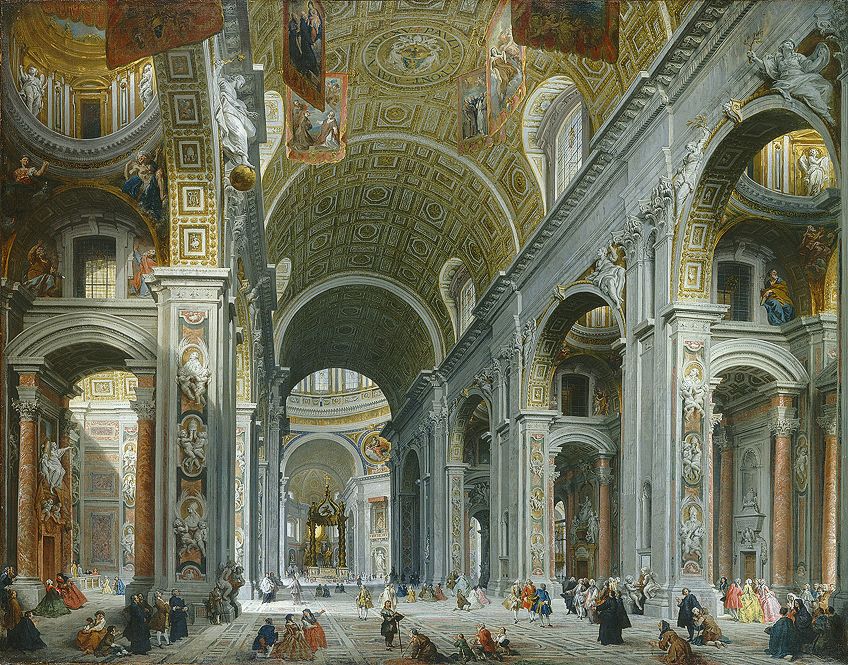 Interior of Saint Peter's, Rome(c. 1754) past Giovanni Paolo Panini;National Gallery of Art, CC0, via Wikimedia Commons
Interior of Saint Peter's, Rome(c. 1754) past Giovanni Paolo Panini;National Gallery of Art, CC0, via Wikimedia Commons
A major claiming that faced the architects was deciding on a new layout and form for religious worship, as the previous designs were created for a different functionality than the Christian method of indoor communion. These new churches needed to exist large in order to business firm the ever-growing Christian fellowship and to make a visible stardom between the faithless and the faithful.
Based on these factors, it was decided to incorporate the architectural form of the basilica and adorn it appropriately with rich religious symbolism and artwork.
Basilicas were non new and had been congenital for centuries previously for use equally extensions to palaces, public coming together halls, or courts of police. These courts usually had a judge presiding from a chair situated at the end of the hall in a semi-circular dome overlooking the hall. This imposing aesthetic carried over from court of law to place of worship, to the priest standing at his altar.
Religious Renaissance Art
During the 13th and 14th centuries, churches became massive patrons of Christian art and commissioned and bought large quantities of work from Christian painters. Many members of the public were unable to write at this time, and then fine art was used to help them envision the scriptures, creating a sense of respect and awe amongst the customs. Churches hoped to apply the art to create a deeper connection with their followers, hoping that the scenes of salvation and damnation would inspire or terrify them into being more than devoted.
Christian artists from the Early Renaissance started adding a touch of realism to their art, making the figures look more than true to life and the settings more natural and realistic.
 The Madonna of the Meadow (c. 1506) by Raphael;Raphael, Public domain, via Wikimedia Commons
The Madonna of the Meadow (c. 1506) by Raphael;Raphael, Public domain, via Wikimedia Commons
By doing so, they hoped to describe the viewer into the artwork and to empathize more with the subjects and field of study matter past recognizing themselves in the faces and settings of the paintings. Throughout this period, artists connected to refine their processes, condign e'er more influential on the masses and simultaneously influenced by the masses.
During this menstruum, church elders were continuously stressing the humanity of Jesus and how the congregation should be leading their lives using his equally an example. Therefore, the artwork of this time depicts a Jesus that portrays human frailties and suffering, every bit well as divinity and themes connected to images of his birth and decease. Both of these periods of Christ'due south life convey aspects of Christian belief that are a fundamental role of the doctrine, being the concepts of incarnation and resurrection.
Let us now look at a few examples of religious Renaissance art.
Madonna and Kid (c. 1300) by Duccio di Buoninsegna
Duccio di Buoninsegna was an extremely influential Renaissance artist of the early 14th century, and his version of the Madonna and child is thought to have been painted sometime around the year 1300. Compared to larger versions of the Madonna and kid institute in churches and altars, this painting is insufficiently minor and was about likely created to be a personal paradigm for devotional employ.
The painting'south utilise for devotional purposes can exist hinted at by the burnt edges, most likely obtained from the use of candles at a small altar at its base.
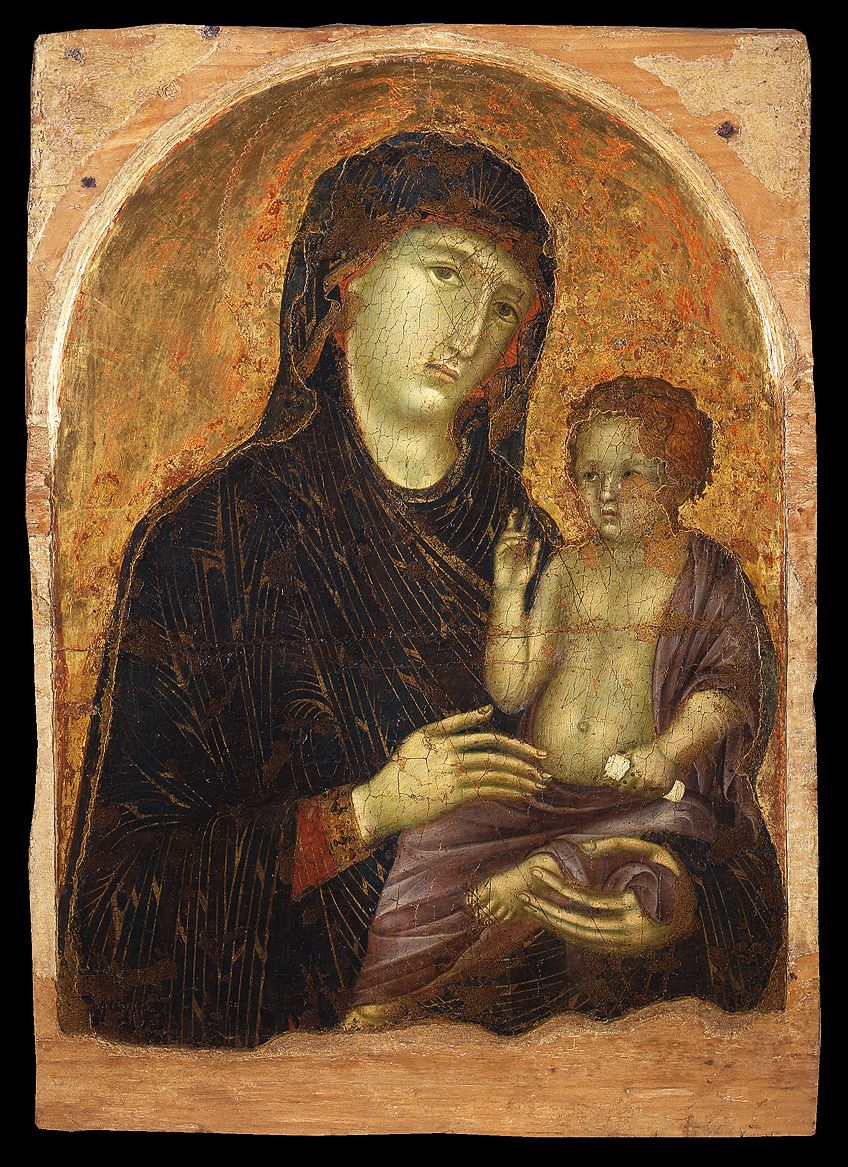 Madonna with Child(between 1295 and 1305) by Duccio di Buoninsegna;Duccio di Buoninsegna, Public domain, via Wikimedia Eatables
Madonna with Child(between 1295 and 1305) by Duccio di Buoninsegna;Duccio di Buoninsegna, Public domain, via Wikimedia Eatables
Despite the simplistic nature of the composition, this artwork marks a departure from the Byzantine era's use of less detailed iconic images, and the attempt to move closer to portraying images likely to create an emotional connection between the viewer and the art slice.
These aspects of humanism tin be seen in the artist's use of emotive homo gestures between the mother and the child sitting on her lap, also as the detailed garments.
The Last Supper (c. 1495) past Leonardo da Vinci
Possibly 1 of the earth'south most hands recognized paintings, Leonard da Vinci painted The Terminal Supper in the late 15th century. Housed in the Covenant of Santa Maria Delle Grazie in Milan, da Vinci started work on the painting effectually 1495 as office of a deputed job to renovate the church past his patron the Duke of Milan, Ludovico Sforza. As the name suggests, the painting depicts the scene of Christ'southward terminal dinner with his apostles.
 The Last Supper (1495-1498) past Leonardo da Vinci;Leonardo da Vinci, Public domain, via Wikimedia Commons
The Last Supper (1495-1498) past Leonardo da Vinci;Leonardo da Vinci, Public domain, via Wikimedia Commons
Da Vinci has tried to capture the moment of consternation amidst his followers as he announces that one of the apostles would eventually beguile him. Each apostle is depicted with a different reaction to his revelation, all displaying varying degrees of daze, anger, and disbelief. As was common with other paintings of the last supper from that era, da Vinci has positioned all the apostles at one side of the table so that none of them take their backs facing the viewer. Most other versions of this scene have Judas placed on the other end of the table away from all the apostles, but in his rendition, Leonardo placed Judas in the shadows.
Despite many attempts at restoration throughout the years, very little of the original painting nevertheless exists.
When Sforza renovated the church building, his builders used moisture-retaining rubble to make full the walls, which resulted in the paint beingness unable to get a decent grip on the walls from the start. In fact, the painting already began to show signs of deterioration shortly afterwards it was finished. 2 copies of The Terminal Supper accept been found that were made by da Vinci's assistants before the final one was painted. One is at present housed at the Royal Academy of Arts and the other is housed at the Church building of St. Ambrogio in Switzerland.
The Creation of Adam (1512) by Michelangelo
Michelangelo painted this famous fresco from 1508 until 1512, and it forms part of the ceiling of the Sistine Chapel. Considered one of the most famous biblical paintings in the world, it depicts the moment God gave life to Adam.
Michelangelo was originally commissioned to paint the twelve apostles on the sides that support the ceiling, merely he managed to convince Pope Julius to give him gratuitous creative reign, suggesting a far more complex scheme than initially devised.
 Cosmos of Adam fresco painted by Michelangelo (1475-1564), Sistine Chapel Ceiling (1508-1512) Rome, Vatican;Jörg Bittner Unna, CC BY 3.0, via Wikimedia Commons
Cosmos of Adam fresco painted by Michelangelo (1475-1564), Sistine Chapel Ceiling (1508-1512) Rome, Vatican;Jörg Bittner Unna, CC BY 3.0, via Wikimedia Commons
Centering around the nine capacity from the Book of Genesis, the composition contains over 300 various figures and stretches over 500 square meters. It is segmented into three parts: the creation of the earth, the creation of humankind, and the fall from the grace of God. God is portrayed as an old, greyness-haired white man cloaked in a swirling robe. Adam is depicted without whatever article of clothing and is reclining on the basis.
God'south right arm is outstretched with his index finger reaching to touch Adam'south finger, thereby bestowing life upon him. Adam'southward left arm is stretched out, a mirror image of the pose of God, a symbolic reflection that human being was fabricated in the image of God. Much debate has arisen equally to the identities of the twelve figures surrounding God.
It is now widely accepted that the female person under God'due south right arm represents Eve and that the other figures represent the children of Eve, the human race.
The Tower of Babel (1563) past Pieter Bruegel the Elder
Pieter Bruegel the Elderberry created three different paintings with the Belfry of Babel every bit its bailiwick matter. The first was painted in Rome and was a miniature created on ivory. The other two are the just surviving works that aren't lost to time. They are referred to every bit the "Cracking" Tower and the "Little" tower. Both of these were painted on wood panels using oil pigment. One is at present housed at the Kunsthistorisches Museum, Vienna, and the other at the Museum Boijmans Van Beuningen in Rotterdam.
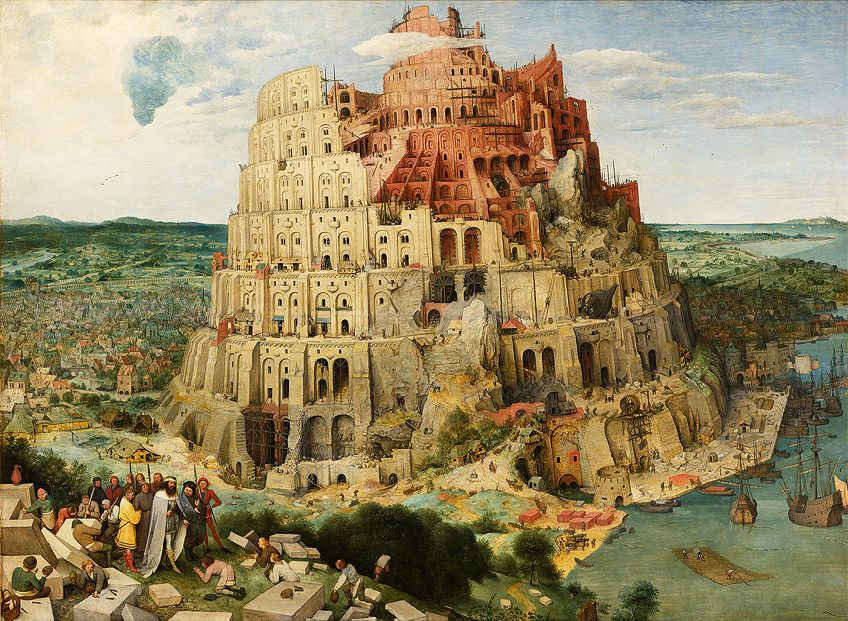 The "Great" Tower of Boom-boom (1563) past Pieter Bruegel the Elder, housed in the Kunsthistorisches Museum, Vienna;Pieter Brueghel the Elderberry, Public domain, via Wikimedia Eatables
The "Great" Tower of Boom-boom (1563) past Pieter Bruegel the Elder, housed in the Kunsthistorisches Museum, Vienna;Pieter Brueghel the Elderberry, Public domain, via Wikimedia Eatables
The painting housed in Rotterdam is approximately half the size of the other one. Although they are based on the same subject area and contain the same basic compositions, once one takes a closer look, it becomes evident that all the details vary greatly, from the landscape to the sky to the vastly dissimilar-looking tower.
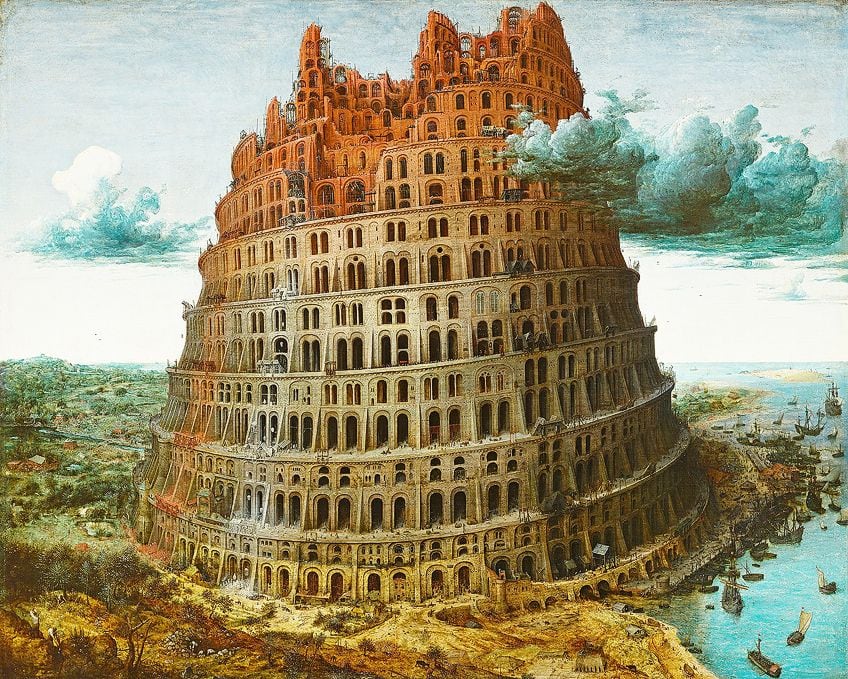 The "Little" Tower of Boom-boom (1568) by Pieter Bruegel the Elder, housed at the Museum Boijmans Van Beuningen in Rotterdam;Pieter Brueghel the Elderberry, Public domain, via Wikimedia Commons
The "Little" Tower of Boom-boom (1568) by Pieter Bruegel the Elder, housed at the Museum Boijmans Van Beuningen in Rotterdam;Pieter Brueghel the Elderberry, Public domain, via Wikimedia Commons
This artwork portrays the building of the Tower of Babylon, a story from the Book of Genesis in which humanity unifies and creates a building that can reach the heavens in celebration of their achievements. This portrayal of the Tower of Babylon contains compages that is notably Roman in character.
Apparently, this was done intentionally to reflect the Christian disdain for Roman rule. Artists in this period were known to constantly depict parallels between Babylonian and Roman societies.
Notable Early Christian Artworks
From Medieval Christian fine art and through to the Renaissance period, Christain artwork has been created in many different mediums such as paintings on canvas and murals on walls to Christian sculptures and architecture. Let the states accept a look at some notable examples of early Christian artworks.
Sarcophagus of Junius Bassus
This early on Christian sarcophagus was made around 359 CE for the burial of Junius Bassus and is fabricated from marble. It is considered the well-nigh famous of Christian sculptures and was originally placed under Old St. Peter's Basilica until its rediscovery in 1597. It is now housed under the Saint Peter'south Basilica Museum in the Vatican. The detailed iconography embraces imagery from the one-time and new Testaments, and along with the Dogmatic Sarcophagus, this Christian sculpture is 1 of the oldest surviving sarcophagi of this quality and status.
 The cast of the Sarcophagus of Junius Bassus (359 AD). This is the oldest Christian sarcophagus embellished by reliefs of biblical and evangelical subjects, which survived until our fourth dimension. At the eye is a scene of Traditio Legis;Giovanni Dall'Orto, Attribution, via Wikimedia Commons
The cast of the Sarcophagus of Junius Bassus (359 AD). This is the oldest Christian sarcophagus embellished by reliefs of biblical and evangelical subjects, which survived until our fourth dimension. At the eye is a scene of Traditio Legis;Giovanni Dall'Orto, Attribution, via Wikimedia Commons
The sarcophagus's possessor, Junius Bassus, was a senator in charge of the majuscule who died at the early on historic period of 42. Equally Bassus was a loftier-ranking official, information technology was believed that information technology was non possible for someone to be both a senator and pious Christian. Nevertheless, it is said that he converted to Christianity on his deathbed. The carvings are on three sides of the sarcophagus, allowing it to be displayed and positioned against a wall. The Anatolian style of arranging reliefs in columnar frameworks can exist seen applied to this fine art piece.
Various scenes are depicted on this sarcophagus such every bit the sacrifice of Isaac, the trial of Jesus, a depiction of Adam and Eve, and the judgment of Peter.
Basilica of Sant'Apollinare Nuovo
The Church of Sant'Apollinare in Classe was originally built and designed past Arian Theodoric as his palace chapel. As part of an attempt to suppress all references to his beliefs, the Catholic Church reconsecrated the Basilica in 561 CE. This included the reworking of the mosaic art he had created. When the artifacts of Saint Apollinaris were transferred in that location in 856 CE, it became known as the Basilica of Saint Apollinaris.
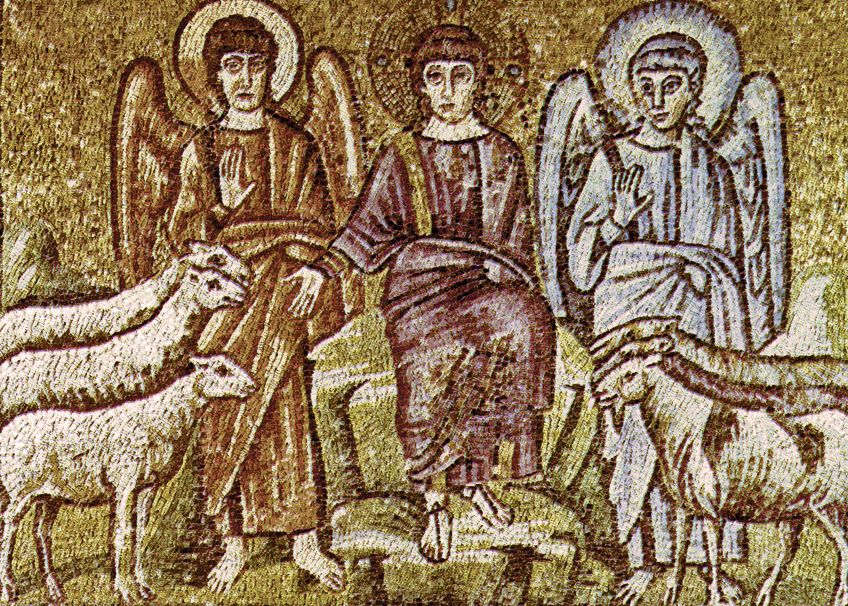 Christ divides the sheep from the kids, Sant'Apollinare Nuovo, Ravenna, sixth century;Basilica of Sant'Apollinare Nuovo, Public domain, via Wikimedia Commons
Christ divides the sheep from the kids, Sant'Apollinare Nuovo, Ravenna, sixth century;Basilica of Sant'Apollinare Nuovo, Public domain, via Wikimedia Commons
Of much interest to scholars are the mosaic works depicting the miracles and teachings of Christ, which have luckily survived regardless of the modernization and considerable renovation of the basilica over the years. Of particular involvement to historians and scholars is the outset advent of the Devil in the history of art; to the left of Jesus appears a scarlet angel situated behind three goats.
The Basilica of Sant'Apollinare Nuovo is a UNESCO World Heritage site and is regarded as one of the well-nigh crucially important sites of Medieval Christian art in Europe. This is chiefly due to the mixture of Eastern and Western Christianity motifs, every bit shown past the Eastern Orthodox (bearded) and Western Orthodox (non-bearded) versions of Christ.
Moses Striking the Stone (1624) – Joachim Anthonisz Wtewael
Moses hitting the Stone was created in 1624 by Joachim Anthonisz Wtewael and typifies his lifelong clan with and utilise of mannerism. Mannerists created artificial yet elegant scenes using elongated figures, alternating light, every bit well as dark patterns and contorted poses. This artwork portrays the moment that God enabled Moses to atomic number 82 the Israelites out of the land of Egypt, as told in the Book of Exodus. Surrounded by the children, women, and animals, Moses strikes the rock with the very same rod that he had previously used to office the Red Sea.
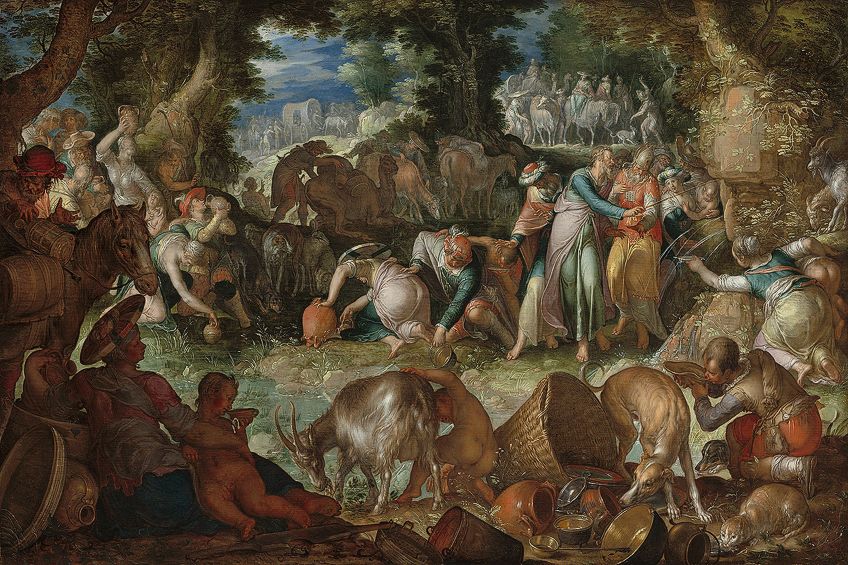 Moses Striking the Rock(1624) by Joachim Anthonisz Wtewael;National Gallery of Art, CC0, via Wikimedia Commons
Moses Striking the Rock(1624) by Joachim Anthonisz Wtewael;National Gallery of Art, CC0, via Wikimedia Commons
This story had particular meaning to the artist and other Dutch people as they were able to draw parallels between their fight for independence from the Castilian and the biblical story. Moses was seen every bit a religious allegory of their own leader, Prince William of Orangish, who was the hero of the Dutch Revolt, and like Moses, did not live to see his promised land.
Wtewael was an agog supporter of Orangish, and it is thought that his determination to paint the scene was done to assist revitalize the public perception of the Prince to their version of Moses incarnate.
Adoration of the Magi (1481) past Leonardo da Vinci
Leonardo da Vinci was commissioned by the monks of San Donato in Florence to paint The Adoration of the Magi in 1481. He, however, departed for Milan the next twelvemonth, leaving the painting incomplete. Since 1670, it has been housed at the Uffizi Gallery in Florence. In this unfinished Christian artwork, da Vinci has portrayed the Virgin Mary and Child in the foreground, and the Magi kneeling at her feet in devotion with the figures all forming a triangular shape on the sail.
 Adoration of the Magi (c. 1481-1482) past Leonardo da Vinci;Leonardo da Vinci, Public domain, via Wikimedia Commons
Adoration of the Magi (c. 1481-1482) past Leonardo da Vinci;Leonardo da Vinci, Public domain, via Wikimedia Commons
In the background, a semicircle of people tin can be seen accompanying the virgin and child, 1 of which seems to be a self-portrait of da Vinci himself. On the left of the groundwork are the ruins of a infidel building. Workmen can exist seen conveying out repair works to sections of it. On the right of the scene is a rocky mural and men fighting on horseback. It has been suggested that the ruins on the left are maybe a reference to the basilica of Maxentius.
It was part of Medieval legend that the basilica would stand until the miracle of a virgin nascency.
The basilica was rumored to accept suddenly complanate on the dark of the nascency of Christ, simply in truth, it would be many years earlier information technology was fifty-fifty built. The palm tree has been said to be a symbolic representation of both aboriginal Rome as well as Mary herself. This is due to the phrase from the vocal of Solomon "you are as stately as a palm tree". Its symbolism of Rome stems from the utilize of the palm tree to stand for the triumph of proficient over evil, and the triumph over death.
Transfiguration (1516 – 1520) by Raphael
Commissioned by Fundamental Giulio de Medici and created for the Narbonne Cathedral in French republic, this altarpiece was the final painting by Raphael, the Italian Renaissance master. He worked on it from 1516 until his death in 1520. From the time of its creation until early in the 20th century, it was regarded as the virtually famous oil painting in the known earth.
 The Transfiguration (1520) by Raphael, unfinished at his expiry; Raphael, Public domain, via Wikimedia Eatables
The Transfiguration (1520) by Raphael, unfinished at his expiry; Raphael, Public domain, via Wikimedia Eatables
This artwork depicts two distinct biblical stories from the Gospel of Matthew. On the tiptop half of the sail is a depiction of the transfiguration of Christ as he radiates in glory, hovering higher up James, John, and Peter, who expect on in wonder. On the lower half of the sail, the apostles attempt and fail to bewitch demons from a kid and eagerly look the return of Jesus. The arrival of Christ has resulted in the kid being cured equally he stands with his mouth afraid and his arm raised towards the hovering Christ.
Equally his last work of art, Raphael created this artwork as his concluding testament to the miraculous ability of Christ to heal the sick. This final masterpiece is said to contain stylistic elements of both Baroque painting and the Mannerism motility. At its most basic level, the painting represents the dichotomy of the Divine nature of Christ contrasted with the struggles and flaws associated with mankind.
We take learned that Christian art was hidden in the early days due to the suppression of Christianity by the Roman Empire. It wasn't until the dominion of Constantine that things changed drastically, where Christianity became the religion ordained by the state and began to flourish. Afterwards that, Christian art could exist found in temples, churches, and public areas. Since the early forbidden days of medieval Christian art through to the Renaissance, Christian fine art has experienced a colorful and epic journey of revival and survival. From the simplistic motifs on makeshift churches to the masterful frescos adorning the walls of chapels and cathedrals, Christian fine art has gone from underdog to overlord.
Have a look at our Christian artwork webstory here!
Frequently Asked Questions
Why Is It And then Hard to Find Early Examples of Christian Art?
In the early days of the religion, about of the people who followed it were too poor to afford fine art supplies. Many of them also believed that God should non be depicted visually, and refrained from creating artwork that portrayed holy deities. Once Constantine inverse the national landscape to one dominated past Christianity, churches started commissioning art and it became socially acceptable and financially viable for them to start creating Christian artwork. Before such a fourth dimension as information technology became adequate, artists had to carefully use symbolism to represent Christ and other Christian motifs in society to hide them from the Roman Empire. After the political and economic situation in the region improved, artists were able to start creating personal works of fine art that were free from persecution from the ruling stare.
What Subject Matter Did Early Christian Artists Pigment?
Equally about works were deputed by the churches, the majority of the subject matter was decided on by the clergy, although some artists were able to enjoy some complimentary reign over what they could paint. The most common subject matter involved scenes of the nascence and decease of Christ, also equally scenes of cosmos such as the story of Adam and Eve, or even apocalyptic scenes. These paintings were created to simultaneously inspire the masses to devotion as well equally instill the fright of hell, thus encouraging submission.
Source: https://artincontext.org/christian-art/
0 Response to "What Does an Old Tradition Consider to Be the First Christian Art Work?"
Post a Comment